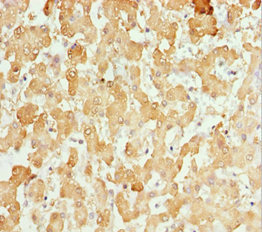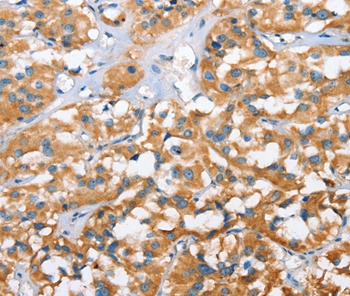CXCL14 antibody [N3C3]
GTX108431
ApplicationsImmunoFluorescence, Western Blot, ImmunoCytoChemistry, ImmunoHistoChemistry, ImmunoHistoChemistry Paraffin
Product group Antibodies
TargetCXCL14
Overview
- SupplierGeneTex
- Product NameCXCL14 antibody [N3C3]
- Delivery Days Customer9
- Application Supplier NoteWB: 1:500-1:3000. IHC-P: 1:100-1:1000. *Optimal dilutions/concentrations should be determined by the researcher.Not tested in other applications.
- ApplicationsImmunoFluorescence, Western Blot, ImmunoCytoChemistry, ImmunoHistoChemistry, ImmunoHistoChemistry Paraffin
- CertificationResearch Use Only
- ClonalityPolyclonal
- Concentration1.44 mg/ml
- ConjugateUnconjugated
- Gene ID9547
- Target nameCXCL14
- Target descriptionC-X-C motif chemokine ligand 14
- Target synonymsBMAC, BRAK, KEC, KS1, MIP-2g, MIP2G, NJAC, SCYB14, C-X-C motif chemokine 14, CXC chemokine in breast and kidney, MIP-2 gamma, bolekine, breast and kidney, chemokine (C-X-C motif) ligand 14, chemokine BRAK, small inducible cytokine subfamily B (Cys-X-Cys), member 14 (BRAK), small-inducible cytokine B14, tumor-suppressing chemokine
- HostRabbit
- IsotypeIgG
- Protein IDO95715
- Protein NameC-X-C motif chemokine 14
- Scientific DescriptionThis gene belongs to the cytokine gene family which encode secreted proteins involved in immunoregulatory and inflammatory processes. The protein encoded by this gene is structurally related to the CXC (Cys-X-Cys) subfamily of cytokines. Members of this subfamily are characterized by two cysteines separated by a single amino acid. This cytokine displays chemotactic activity for monocytes but not for lymphocytes, dendritic cells, neutrophils or macrophages. It has been implicated that this cytokine is involved in the homeostasis of monocyte-derived macrophages rather than in inflammation. [provided by RefSeq]
- Storage Instruction-20°C or -80°C,2°C to 8°C
- UNSPSC12352203
References
- Goto A, Komura S, Kato K, et al. C-X-C domain ligand 14-mediated stromal cell-macrophage interaction as a therapeutic target for hand dermal fibrosis. Commun Biol. 2023,6(1):1173. doi: 10.1038/s42003-023-05558-8Read this paper
- Chang TM, Chiang YC, Lee CW, et al. CXCL14 promotes metastasis of non-small cell lung cancer through ACKR2-depended signaling pathway. Int J Biol Sci. 2023,19(5):1455-1470. doi: 10.7150/ijbs.79438Read this paper
- Cao Q, Chen H, Deng Z, et al. Genetic deletion of Cxcl14 in mice alters uterine NK cells. Biochem Biophys Res Commun. 2013,435(4):664-70. doi: 10.1016/j.bbrc.2013.04.106Read this paper




